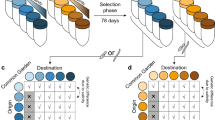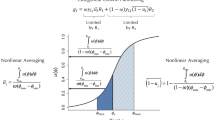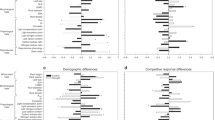Abstract
Ecological explanations for species coexistence assume that species’ traits, and therefore the differences between species, are fixed on short timescales. However, species’ traits are not fixed, but can instead change rapidly as a consequence of phenotypic plasticity. Here we use a combined experimental–theoretical approach to demonstrate that plasticity in response to interspecific competition between two aquatic plants allows for species coexistence where competitive exclusion is otherwise predicted to occur. Our results show that rapid trait changes in response to a shift in the competitive environment can promote coexistence in a way that is not captured by common measures of niche differentiation.


Similar content being viewed by others
Data availability
The data that support the findings of this study are available via Zenodo at https://doi.org/10.5281/zenodo.5726004.
Code availability
The R code used to analyse the data is available via Zenodo at https://doi.org/10.5281/zenodo.6844013.
References
Pigliucci, M. Phenotypic plasticity: Beyond Nature and Nurture (Johns Hopkins Univ. Press, 2001).
Chesson, P. Mechanisms of maintenance of species diversity. Annu. Rev. Ecol. Syst. 31, 343–366 (2000).
Aerts, R., Boot, R. G. A. & Van Der Aart, P. J. M. The relation between above- and belowground biomass allocation patterns and competitive ability. Oecologia 87, 551–559 (1991).
Ashton, I. W., Miller, A. E., Bowman, W. D. & Suding, K. N. Niche complementarity due to plasticity in resource use: plant partitioning of chemical N forms. Ecology 91, 3252–3260 (2010).
Pfennig, D. W., Rice, A. M. & Martin, R. A. Ecological opportunity and phenotypic plasticity interact to promote character displacement and species coexistence. Ecology 87, 769–779 (2006).
van Kleunen, M. & Fischer, M. Adaptive evolution of plastic foraging responses in a clonal plant. Ecology 82, 3309–3319 (2001).
Relyea, R. A. Competitor-induced plasticity in tadpoles: consequences, cues, and connections to predator-induced plasticity. Ecol. Monogr. 72, 523–540 (2002).
Broekman, M. J. E. et al. Signs of stabilisation and stable coexistence. Ecol. Lett. 22, 1957–1975 (2019).
Callaway, R. M., Pennings, S. C. & Richards, C. L. Phenotypic plasticity and interactions among plants. Ecology 84, 1115–1128 (2003).
Turcotte, M. M. & Levine, J. M. Phenotypic plasticity and species coexistence. Trends Ecol. Evol. 31, 803–813 (2016).
Chesson, P. in Unity in Diversity: Reflections on Ecology after the Legacy of Ramon Margalef (eds F. Valladares et al.) 119–164 (Fundación Banco Bilbao Vizcaya Argentaria, 2008).
Ellner, S. P., Snyder, R. E. & Adler, P. B. How to quantify the temporal storage effect using simulations instead of math. Ecol. Lett. 19, 1333–1342 (2016).
Vasseur, D. A., Amarasekare, P., Rudolf, V. H. W. & Levine, J. M. Eco-evolutionary dynamics enable coexistence via neighbor-dependent selection. Am. Nat. 178, E96–E109 (2011).
Hendry, A. P. Key questions on the role of phenotypic plasticity in eco-evolutionary dynamics. J. Hered. 107, 25–41 (2016).
Hart, S. P., Turcotte, M. M. & Levine, J. M. Effects of rapid evolution on species coexistence. Proc. Natl Acad. Sci. USA 116, 2112–2117 (2019).
Hart, S. P., Freckleton, R. P. & Levine, J. M. How to quantify competitive ability. J. Ecol. 106, 1902–1909 (2018).
Grainger, T. N., Levine, J. M. & Gilbert, B. The invasion criterion: a common currency for ecological research. Trends Ecol. Evol. 34, 925–935 (2019).
Letten, A. D., Ke, P.-J. & Fukami, T. Linking modern coexistence theory and contemporary niche theory. Ecol. Monogr. 87, 161–177 (2017).
Kraft, N. J. B., Godoy, O. & Levine, J. M. Plant functional traits and the multidimensional nature of species coexistence. Proc. Natl Acad. Sci. USA 112, 797–802 (2015).
Pfennig, D. W. & Murphy, P. J. How fluctuating competition and phenotypic plasticity mediate species divergence. Evolution 56, 1217–1228 (2002).
Adler, P., HilleRisLambers, J. & Levine, J. A niche for neutrality. Ecol. Lett. 10, 95–104 (2007).
Barabás, G., D’Andrea, R. & Stump Simon, M. Chesson’s coexistence theory. Ecol. Monogr. 88, 277–303 (2018).
Pfennig, D. W. & Pfennig, K. S. Evolution’s Wedge: Competition and the Origins of Diversity (Univ. California Press, 2012).
Ayala, F. J. Reversal of dominance in competing species of Drosophila. Am. Nat. 100, 81–83 (1966).
Pease, C. M. On the evolutionary reversal of competitive dominance. Evolution 38, 1099–1115 (1984).
Pimentel, D., Feinberg, E. H., Wood, P. W. & Hayes, J. T. Selection, spatial distribution, and the coexistence of competing fly species. Am. Nat. 99, 97–109 (1965).
Lankau, R. A. & Strauss, S. Y. Mutual feedbacks maintain both genetic and species diversity in a plant community. Science 317, 1561–1563 (2007).
Kunstler, G. et al. Plant functional traits have globally consistent effects on competition. Nature 529, 204–207 (2016).
Stuart, Y. E. & Losos, J. B. Ecological character displacement: glass half full or half empty? Trends Ecol. Evol. 28, 402–408 (2013).
Abrams, P. A. Alternative models of character displacement and niche shift. 2. Displacement when there is competition for a single resource. Am. Nat. 130, 271–282 (1987).
Chevin, L. M., Lande, R. & Mace, G. M. Adaptation, plasticity, and extinction in a changing environment: towards a predictive theory. PLoS Biol. 8, e1000357 (2010).
Harmon, E. A. & Pfennig, D. W. Evolutionary rescue via transgenerational plasticity: evidence and implications for conservation. Evol. Dev. 23, 292–307 (2021).
Forsman, A. Rethinking phenotypic plasticity and its consequences for individuals, populations and species. Heredity 115, 276–284 (2015).
Brass, D. P. et al. Phenotypic plasticity as a cause and consequence of population dynamics. Ecol. Lett. 24, 2406–2417 (2021).
Macarthur, R. H. & Levins, R. The limiting similarity, convergence, and divergence of coexisting species. Am. Nat. 101, 377–385 (1967).
Beverton, R. J. H. & Holt, S. J. On the Dynamics of Exploited Fish Populations (UK Ministry of Agriculture, Fisheries and Food, 1957).
Landolt, E. Biosystematic Investigations in the Family of Duckweeds (Lemnaceae), Vol. 2: The Family of Lemnaceae—A Monographic Study, Vol.1 (Geobotanischen Institute, ETH Zürich, 1986).
Wang, W. et al. The Spirodela polyrhiza genome reveals insights into its neotenous reduction fast growth and aquatic lifestyle. Nat. Commun. 5, 3311 (2014).
Hoagland, D. R. & Arnon, D. I. The Water-Culture Method for Growing Plants without Soil (College of Agriculture, Agricultural Experiment Station, Univ. California, 1950).
Inouye, B. D. Response surface experimental designs for investigating interspecific competition. Ecology 82, 2696–2706 (2001).
Law, R. & Watkinson, A. R. Response-surface analysis of two-species competition: an experiment on Phleum arenarium and Vulpia fasciculata. J. Ecol. 75, 871–886 (1987).
MATLAB v.9.0 (MathWorks, 2016).
Stan Modeling Language Users Guide and Reference Manual, v.2.27 (Stan Development Team, 2021); https://mc-stan.org
Vehtari, A., Gelman, A. & Gabry, J. Practical Bayesian model evaluation using leave-one-out cross-validation and WAIC. Stat. Comput. 27, 1413–1432 (2017).
Bürkner, P.C. brms: an R package for Bayesian multilevel models using Stan. J. Stat. Softw. https://doi.org/10.18637/jss.v080.i01 (2017).
Vehtari, A. et al. loo: efficient leave-one-out cross-validation and WAIC for Bayesian models, v.2.4.1 (2020).
ImageJ (US NIH, 1997–2016).
Acknowledgements
We thank A. Reid, A. Bieger, M.-J. Mächler, S. Schmid, L. Willi, C. Wälthi, M. de Oliveira Negreiros, N. Schumacher and P. Seiler for assistance with the experiments. We also thank C. Pietsch, S. Egloff and A. Seitz from ZHAW Zurich University of Applied Sciences, who provided the initial culture of the S. polyrhiza genotype. We thank J. Dwyer and A. Letten for advice on the statistical analyses. Finally, we thank W. Hart for the suggestion and inspiration to pursue this project in the first place.
Author information
Authors and Affiliations
Contributions
C.H., J.M.L., M.M.T. and S.P.H. conceived the problem and designed the experiments; C.H. did the experiments; S.P.H. did the analyses; C.H. and S.P.H. wrote the first draft of the manuscript; S.P.H. led the subsequent writing and all authors contributed to revisions.
Corresponding author
Ethics declarations
Competing interests
The authors declare no competing interests.
Peer review
Peer review information
Nature Ecology & Evolution thanks György Barabás, Nicholas Kortessis and the other, anonymous, reviewer(s) for their contribution to the peer review of this work. Peer reviewer reports are available.
Additional information
Publisher’s note Springer Nature remains neutral with regard to jurisdictional claims in published maps and institutional affiliations.
Extended data
Extended Data Fig. 1 The effect of plasticity on demographic and competitive rates.
a) Maximum finite rate of growth (λi); and b) sensitivity of focal species i to interspecific competition (αij). Plots show the posterior probability densities of the difference in these competition model parameters between treatments, accounting for correlations in the posterior distributions of the parameters. The vertical dotted lines indicate zero difference between treatments. Positive values indicate parameter values are higher in the heterospecific plasticity-induction treatment. Higher λi and lower αij for focal species i in the heterospecific plasticity-induction treatment will increase invasion growth rates (see equation 3), and therefore the arrows below the plots indicate the direction of parameter change that would favour coexistence by increasing invasion growth rates. Posterior probabilities for increases in each species maximum finite rate of growth (λi) were 0.98 and 0.97 for S. polyrhiza and L. minor, respectively. Posterior probabilities for decreases in each species’ sensitivity to interspecific competition were 0.92 and 0.68 for S. polyrhiza and L. minor, respectively. Point estimates (means) and variability (standard deviations and 2.5 & 97.5 quantiles) calculated from the posterior distributions for each competition model parameter are provided in Supplementary Table 2.
Extended Data Fig. 2 The effect of plasticity on functional traits.
a) Specific leaf area (SLA); and b) the ratio of root length to frond biomass. Plots show the posterior probability densities for the estimate of each trait value, for each species and plasticity treatment. Raw data are shown as points on the x-axis.
Extended Data Fig. 3 The effect of plasticity on trait divergence.
The plots show the posterior probability densities of the difference in specific leaf area (SLA) between the heterospecific competitor and a focal species from the heterospecific vs. conspecific plasticity-induction treatments. The traits of the heterospecific competitor were measured after its own plasticity in response to itself (that is in its own conspecific plasticity-induction treatment). Positive values indicate that trait differences between species increase (that is, there is trait divergence) when the focal species is exposed to interspecific competition (that is, in the heterospecific plasticity treatment) and negative values indicate plasticity causes trait differences between species to decrease (that is, there is trait convergence) when the focal species is exposed to interspecific competition. These contrasting possibilities are indicated by the arrows either side of the dotted vertical line, which represents zero trait divergence/convergence.
Supplementary information
Supplementary Information
Supplementary details, Figs. 1–3 and Tables 1 and 2.
Rights and permissions
About this article
Cite this article
Hess, C., Levine, J.M., Turcotte, M.M. et al. Phenotypic plasticity promotes species coexistence. Nat Ecol Evol 6, 1256–1261 (2022). https://doi.org/10.1038/s41559-022-01826-8
Received:
Accepted:
Published:
Issue Date:
DOI: https://doi.org/10.1038/s41559-022-01826-8
- Springer Nature Limited
This article is cited by
-
Inverse relationship between species competitiveness and intraspecific trait variability may enable species coexistence in experimental seedling communities
Nature Communications (2024)
-
Vegetative organs morphological plasticity of Ludwigia grandiflora in flooded and flood-free habitats
Plant Systematics and Evolution (2023)
-
Understanding and applying biological resilience, from genes to ecosystems
npj Biodiversity (2023)





